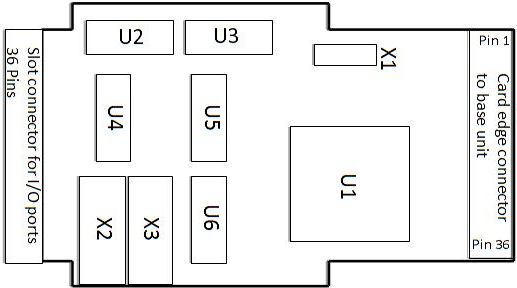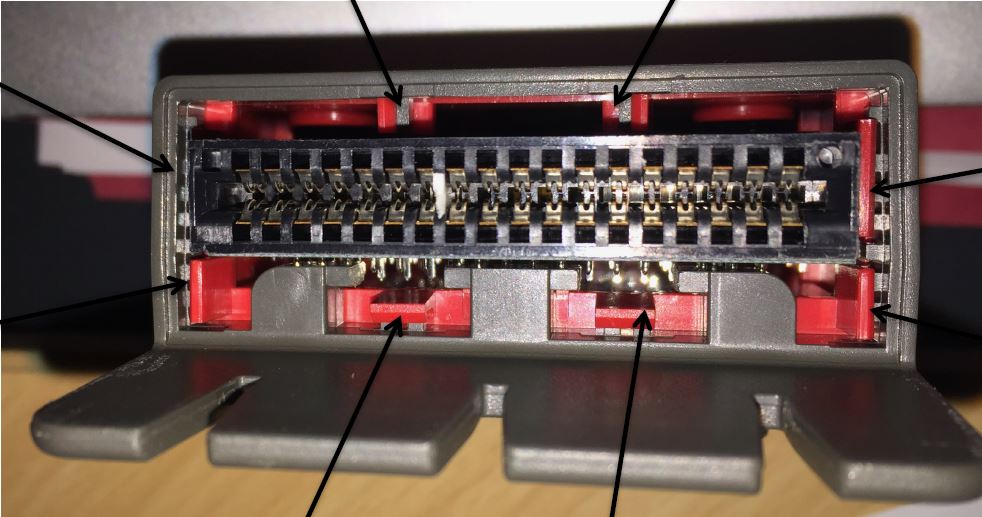|
Digital Input/Output Module (DIO)
DIO Jack Adapter 04G5942
DIO Cable Adapter 04G5941
Rotary Motion Probe (RMP) 04G5944
Photo Event Probe (PEP) 04G5948
Laser Source 04G5951
Precision Picket Fence PSL7134
If you have documentation or actual experience with the PSL,
we would like to hear it.
Digital
Input/Output Module (DIO) 04G5940 (DIO
module)
This module contains the interface
electronics for the RMP and PEP, and can also be used to
monitor or control a variety of external devices. It
provides eight fully protected digital input lines, eight
digital output lines with sufficient power to drive small
motors, two relays and access to the counting and timing
functions of the Base Unit. The module input/output
signals may be accessed using the cable adapter, or
plugging a PSL Prototype card directly into the rear of
the module. The DIO module is fully supported by a
comprehensive technical reference to help you or your
students develop custom accessories and programs.
Eight protected outputs, eight protected inputs, and two
relays (Form C)
Four pulse width modulators
Pulse counting and timing on all inputs
Supports up to two Rotary Motion Probes (RMP)
Supports up to two chains of four Photo Event Probes (PEP)
each
The prototype card can be used to create unique output
connections
DIO User Guide 37G0090 (DIO module)
DIO PCB
Components 
U1 A1020A-PL68C
U2,3 SN75C189N
U4,5 SN754410NE
|
U6 ULN2003A
X1 CSB 250D Ceramic Resonator
X2,3 AZ830-2C-5DSE Relay
|
Actel A1020A-PL68C datasheet
Antifuse. Not hackable. 2,000 gates, 1.2um CMOS
SN75C189N Quadruple Low-Power Line Receiver datasheet TI
Support
SN754410NE Quadruple Half-H Driver datasheet TI Support
ULN2003A High-Voltage, High-Current Darlington Array datasheet
AZ830-2C-5DSE Polarized DIP Relay datasheet
CSB 250D Ceramic Resonator datasheet

David Ress got his DIO module, and he got the front off.
His last words were "My God, it's full of stars"...
Actually, he said "Clips overlapping on the front of the
module".
Disassembly of
DIO Module 8MB of bloat...
DIO Jack
Adapter 04G5942 (DIO module)
This adapter provides two modular jacks
to interface the DIO module to the RMP, PEP and other
digital accessories that use a modular plug.
DIO Cable
Adapter 04G5941 (DIO module)
Use this DIO adapter to connect the
Digital Input/Output Module to a variety of switches,
relays, motors, robots or other devices in your
laboratory. The Cable Adapter connects to the rear of the
DIO module and provides full access to the interface
signals of the DIO via a 34-conductor flat ribbon cable.
The one meter cable is terminated with a 2 row by 17
position connector designed to mate with a standard 0.100
inch spacing pin header. The DIO Technical Reference gives
complete details of the signals available.
Rotary Motion
Probe (RMP) 04G5944 (DIO module)
This patented, PSL unique probe is a
true motion microscope. It measures angular position with
a resolution of 0.25 degrees (that's 1440 counts per
revolution!) and linear position to 0.1 mm. This probe is
simple to use and requires no calibration, yet can reveal
relationships never before seen in the classroom. When
used with the optional accessory kit, the RMP can perform
many of the linear and angular experiments common in the
physics classroom. Also has applications in physiology and
biology for muscle deflection, etc.
RMP User Guide 37G009 (DIO module)
Rotary Motion
Accessory Kit 04G5945 (DIO module)
Two inner masses, two outer ring
masses, a pendulum rod, an RMP shaft adapter, a
thumbscrew, a spool of “special” (non-elastic) thread, and
two springs, allow the RMP to perform a great variety of
experiments. The RMP User Guide gives typical applications
for the physics classroom.
Rotary Motion
Probe Kit PSL7510 (DIO module)
Includes the Rotary Motion Probe and
RMP Accessory Kit.
RMP Springs
(package of 10) PSL7133 (DIO module)
Photo Event
Probe (PEP) 04G5948 (DIO module)
A photogate so unique we had to give it
a new name. With a rise time of less than two
microseconds, this probe is truly faster than a speeding
bullet, and we measured the speed of a bullet with this
probe to prove it. The PEP uses a visible red LED light
source and is fully configurable for photo-timing of
objects as small as a thread or as large as a softball.
When used with the Laser Source, it can time objects
larger than a bus. The mounting system also allows the PEP
to be used as a reflective sensor, enabling many new
applications.
PEP User Guide 37G009 (DIO module)
Laser Source
04G5951 (DIO module)
A 1 milliwatt visible ( 670 nm red)
class II laser for stand-alone laser experiments or use in
conjunction with the Photo Event Probe. The Laser Source
can be used in place of the LED Source in a PEP to greatly
extend the range of separation between the Source and
Receiver. The Laser Source comes with a 4 meter cable for
use with the PEP or may be connected directly to the
Digital Input / Output Module Jack Adapter.
Precision
Picket Fence PSL7134 (DIO module)
The PSL Precision Picket Fence is
designed for use with the PSL Photo Event Probe (PEP) to
provide students an easy and accurate method to measure
the free-fall acceleration due to gravity. Machined slots
in a Lexan™ base ensures high accuracy and immunity to
damage from handling and storage. The fence can also be
attached to moving objects such as cars to measure their
velocity using the PEP.
|